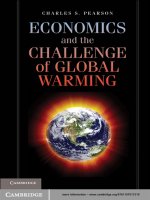International business the challenge of global competition 13th edition ball test bank
Bạn đang xem bản rút gọn của tài liệu. Xem và tải ngay bản đầy đủ của tài liệu tại đây (404.93 KB, 115 trang )
Chapter 02
International Trade and Foreign Direct Investment
True / False Questions
1. Record levels of American outward foreign direct investment from 2000 to 2009,
totaling more than $2 trillion, caused U.S. exports to decline during this time
period.
True
False
2. Small and medium-sized enterprises accounted for nearly one-third of all U.S.
exporters.
True
False
3. International trade includes exports, imports, and foreign direct investment.
True
False
4. Importing and foreign direct investment are two approaches to meeting overseas
demand.
True
False
5. International firms must export their products or services in order to establish and
expand their overseas operations.
True
False
6. The dollar value of total world exports in 2010 was greater than the gross national
product of every nation in the world except China.
True
False
7. The magnitude of international trade and how it has grown are reflected in the fact
that one-fourth of everything grown or made in the world is now exported.
True
False
8. Globally, the overall level and rate of growth of merchandise exports exceed those
of commercial services.
True
False
9. The proportion of merchandise exports coming from Latin America and the Middle
East decreased between 1980 and 2010.
True
False
10. The level of merchandise exports coming from Africa decreased between 1980 and
2010.
True
False
11. The proportion of merchandise exports coming from Asia increased by over 90
percent between 1980 and 2010, with China accounting for nearly two-thirds of
that increase.
True
False
12. In 2009, the top 10 exporting and importing nations collectively accounted for over
half of all exports and imports of merchandise and services worldwide.
True
False
13. Both developed nations and developing nations tend to trade more with
developed nations.
True
False
14. Approximately 70 percent of the exports from developed countries go to
developed countries.
True
False
15. The development of expanded regional trade agreements, such as the Association
of Southeast Asian Nations, Mercosur, and the EU, can substantially alter the level
and proportion of trade flows within and across regions.
True
False
16. There are a number of advantages in focusing attention on a nation that is already
a sizable purchaser of goods coming from the would-be exporter's country.
True
False
17. China, Mexico, and Japan are the three largest trading partners of the United
States, in terms of the total volume of imports and exports.
True
False
18. The first formulation of international trade theory, by Adam Smith, was motivated
by political considerations.
True
False
19. The central idea of mercantilism is that there should be an export surplus so a
nation can accumulate precious metals.
True
False
20. Arguments in support of mercantilism largely disappeared after the end of the
mercantilist era in the late 1700s.
True
False
21. The theory of absolute advantage suggests that under free, unregulated trade,
each nation should specialize in producing those goods it can produce most
efficiently.
True
False
22. Adam Smith explained how countries can benefit from international trade even if
they lack any absolute advantage over their trade partners.
True
False
23. According to the theory of comparative advantage, a nation can gain from trade if
it is not equally less efficient in producing two goods.
True
False
24. If a Chinese worker earns $1 a day, then goods produced by this worker will cost
less than the same goods produced by an American earning $18 an hour.
True
False
25. An arrangement in which one or more activities that could be provided in-house
are instead provided by another company is offshoring.
True
False
26. Some observers have argued that American industry and the American economy
as a whole will be strengthened by offshoring activities to workers in India or other
nations that have comparative advantages in areas such as labor costs.
True
False
27. The price of one currency stated in terms of another currency is the exchange
rate.
True
False
28. Currency devaluation helps a nation avoid losing markets and regain
competitiveness in world markets.
True
False
29. Linder's theory of overlapping demand explains the direction of trade for minerals
and agricultural products.
True
False
30. Michael Porter claims that demand conditions, factor conditions, related and
supporting industries, and firm strategy, structure, and rivalry, rather than
government and chance, are factors that affect national competitiveness.
True
False
31. A nation's relative ability to design, produce, distribute, or service products within
an international trading context, while earning increasing returns on its resources,
is known as national competitiveness.
True
False
32. The primary reason for international trade is a lack of natural resources in the
developed nations.
True
False
33. According to the text, differences in taste, a demand variable, can reverse the
direction of trade predicted by the theory.
True
False
34. International trade theory shows that nations will attain a higher level of living by
specializing in goods for which they possess a comparative advantage and
importing those for which they have a comparative disadvantage.
True
False
35. Portfolio investment is the purchase of sufficient stock in a firm to obtain
significant management control.
True
False
36. Direct investment refers to overseas purchases of stocks and bonds to gain a
return on the funds invested.
True
False
37. The book value, or the value of the total outstanding stock, of all foreign direct
investment worldwide was $19 trillion at the beginning of 2010.
True
False
38. The proportion of the outstanding stock of foreign direct investment accounted for
by the United States declined by two-thirds between 1980 and 2010.
True
False
39. Reflecting their continued economic development, developing countries have
dramatically increased their share of FDI stock, from 1 percent in 1980 to 14 percent
in 2010.
True
False
40. An important development in the level of worldwide FDI is the emergence of what
has been called the "bamboo network" of ethnic Chinese family businesses based
outside China.
True
False
41. Historically, approximately two-thirds of the value of corporate investments made
in the United States from abroad has been spent to acquire going companies
rather than to establish new ones.
True
False
42. Industrialized nations invest primarily in one another just as they trade more with
one another.
True
False
43. If a nation is continuing to receive appreciable amounts of foreign investment, its
investment climate must be favorable.
True
False
44. Historically, foreign direct investment has followed foreign trade, and one reason is
that foreign trade is typically less costly and less risky than making a direct
investment into foreign markets.
True
False
45. Developed by the United Nations Conference on Trade and Development, the
Trade and Development Index is a tool whose goal is to assist efforts "to
systematically monitor the trade and development performance of developing
countries with a view to facilitating national and international policies and
strategies that would ensure that trade serves as a key instrument of
development."
True
False
46. Foreign direct investment may be an attempt by foreign companies to establish
competitive advantage over potential competitors in other markets, due to
possession of advantages not available to local firms. Such advantages possessed
by foreign companies over their local competitors include knowledge about local
market conditions and cost efficiencies from operating at a distance.
True
False
47. Internalization theory suggests that what an organization is good at should not be
outsourced without very careful consideration.
True
False
48. The dynamic capability theory states that for a firm to invest overseas, it must have
three kinds of advantages: ownership specific, internalization, and location
specific.
True
False
49. Dunning's eclectic theory of international production provides an explanation for
the choice by the international firm of its overseas production facilities.
True
False
50. The major part of foreign direct investment is made by large, research-intensive
firms in oligopolistic industries.
True
False
Multiple Choice Questions
51. According to the Exporter Data Base, small and medium-sized enterprises
accounted for ___________ of all U.S. exporters.
A. under 10 percent
B. 25 percent
C. nearly half
D. 86 percent
E. nearly 98 percent
52. Regarding the volume of international trade, exports of goods and services
___________ in 2010.
A. were nearly $4.0 trillion
B. reached $5.8 trillion
C. were $10.4 trillion
D. were nearly $19.0 trillion
E. exceeded $24.5 trillion
53. One measure of the magnitude of international trade and how it has grown is that
_____________ of everything grown or made in the world is now exported.
A. 10 percent
B. 25 percent
C. 32 percent
D. 45 percent
E. over two-thirds
54. In examining the volume of international trade:
A. exports of merchandise grew nearly fivefold between 1990 and 2010.
B. exports of services grew more than 10-fold between 1980 and 2010.
C. the proportion of world exports of commercial services accounted for by the
United States fell by nearly 20 percent between 1980 and 2010.
D. all of the above.
E. two of A, B, and C.
55. The level of merchandise exports in 2010, worldwide, was:
A. $3.7 trillion.
B. $8.5 trillion.
C. $15.2 trillion.
D. $18.9 trillion.
E. $23.4 trillion.
56. The level of services exports in 2010, worldwide, was:
A. $3.7 trillion.
B. $8.5 trillion.
C. $15.2 trillion.
D. $18.9 trillion.
E. $23.4 trillion.
57. Between 1980 and 2010, the level of merchandise exports from Africa:
A. doubled as a proportion of overall world merchandise exports.
B. increased by 250 percent.
C. declined by half.
D. grew more rapidly as a proportion of world merchandise exports than did the
European Union.
E. two of the above.
58. The proportion of world commercial services exports accounted for by ___________
has evidenced an overall decline since 1980.
A. the European Union
B. Africa
C. the United States
D. all of the above
E. two of A, B, and C
59. The proportion of world commercial services exports accounted for by ____________
has evidenced an overall decline since 1980.
A. Asia
B. the Middle East
C. Latin America
D. all of the above
E. two of A, B, and C
60. The rapid expansion of world exports since 1980 demonstrates that:
A. businesspeople must be prepared to meet increased competition.
B. domestic business cannot compete with cheap imports.
C. the opportunity to increase sales by exporting is a viable growth strategy.
D. all of the above.
E. two of A, B and C
61. In examining the volume of international trade:
A. the proportion of manufacturing value added generated by South and East Asia
has quadrupled since 1980.
B. the proportion of manufacturing value added generated by Latin America has
doubled since 1980.
C. the proportion of world exports and imports accounted for by the 10 largest
exporting and importing nations exceeded 70 percent in 2010.
D. all of the above.
E. two of A, B, and C.
62. More than one-half of the exports from developing countries go to __________
countries, and this proportion has been _____________ over the past 35 years.
A. developed; increasing
B. developing; increasing
C. developed; decreasing
D. developing; decreasing
E. none of the above
63. More than half of the exports from developing nations go to developed nations,
and:
A. this proportion has been declining over the past 35 years.
B. approximately 70 percent of exports from developed economies also go to
other industrialized nations.
C. the proportion of world trade accounted for by members of regional trade
agreements has grown to nearly 50 percent.
D. all of the above.
E. two of A, B, and C.
64. When considering where to export, advantages to managers of focusing on a
nation that is already a sizable purchaser of goods coming from the home country
include:
A. the cultures of the two countries should be relatively similar and compatible.
B. the climate for foreign direct investment in the importing nation is relatively
favorable.
C. export and import regulations are not insurmountable.
D. all of the above.
E. two of A, B, and C.
65. When considering where to export, advantages to managers of focusing on a
nation that is already a sizable purchaser of goods coming from the home country
include:
A. the political climate in the importing nation is relatively stable.
B. there are abundant natural resources in the importing nation.
C. satisfactory transportation facilities have already been established.
D. all of the above.
E. two of A, B, and C.
66. The three largest markets for American exports of goods in 2010 were:
A. Japan, the UK, and China.
B. Japan, Mexico, and the UK.
C. Canada, Mexico, and China.
D. Canada, Japan, and the UK.
E. Japan, Mexico, and China.
67. The three nations that exported the largest amount of goods to the United States
in 2010 were:
A. Japan, Canada, and China.
B. China, Mexico, and the UK.
C. Japan, China, and Saudi Arabia.
D. Canada, Japan, and Mexico.
E. Canada, Mexico, and China.
68. Many of the Asian countries that are major exporters to the United States are also
significant importers of American goods because:
A. their rising standards of living enable their people to afford more imported
products.
B. they are purchasing large amounts of capital goods to further their industrial
expansion.
C. they are importing raw materials and components that will be assembled and
subsequently be exported, often to the United States.
D. all of the above.
E. two of A, B, and C.
69. Supporters of mercantilism:
A. viewed accumulation of precious metals as an activity essential to a nation's
welfare.
B. viewed industrial development as the primary source of a nation's wealth.
C. promoted trade policies that generally benefited consumers and emerging
industrialists.
D. all of the above.
E. two of A, B, and C.
70. Mercantilists believed that:
A. merchants should import goods to raise the level of living.
B. governments should lower import duties.
C. a nation should have an export surplus in order to accumulate precious metals.
D. a nation should produce goods for which there is a comparative advantage.
E. two of the above.
71. Adam Smith claimed that:
A. governments, not market forces, should determine the directions, volume, and
composition of international trade.
B. a nation could trade advantageously if it had a comparative advantage.
C. market forces, not government controls, should determine direction, volume,
and the composition of international trade.
D. customers' tastes are affected by income levels.
E. two of the above.
72. The capability of one nation to produce more of a good with the same amount of
input than another country is:
A. a comparative advantage
B. an absolute advantage
C. a mercantilist advantage
D. none of the above
E. two of A, B, and C
73. If Ecuador has an absolute advantage in coffee and Argentina in wheat, then,
according to trade theory:
A. Ecuador should focus production on coffee and trade for wheat.
B. Ecuador would do well to produce its own coffee rather than import it from
Bolivia.
C. Argentina should focus on producing wheat and trade for coffee.
D. all of the above.
E. two of A, B, and C.
74. A nation having absolute disadvantages in the production of two goods with
respect to another nation has ___________ in the production of the good in which its
absolute disadvantage is less.
A. a comparative advantage
B. an absolute advantage
C. a mercantilist advantage
D. none of the above
E. two of A, B, and C
75. According to the theory of comparative advantage:
A. a nation should produce those goods which it is more efficient at producing
than are other nations.
B. a nation can gain from trade if it is equally inefficient in producing two goods.
C. a nation must have an absolute advantage in at least one good to gain from
trade.
D. all of the above.
E. none of A, B, or C.
76. Locating activities in another nation is:
A. outsourcing.
B. offshoring.
C. foreign direct investment.
D. all of the above.
E. two of A, B, and C.
77. Offshoring is an application of:
A. comparative advantage.
B. differences in taste.
C. money market rates.
D. exchange rate theory.
E. none of the above.
78. According to trade theory:
A. traders need to know the exchange rate between their own currency and that of
the nation they are considering trading with before they can decide whether it is
advantageous to import, export, or buy locally.
B. if a currency's exchange rate strengthens, then its exporters will no longer be
able to profitably export their products.
C. devaluation of a currency will automatically cause a nation's products to be
price-competitive in international markets.
D. all of the above.
E. two of A, B, and C.
79. Theory based on ____________________ states that international and interregional
differences in production costs occur because of differences in the supply of
production factors.
A. comparative advantage
B. absolute advantage
C. mercantilist advantage
D. resource endowments
E. none of the above









